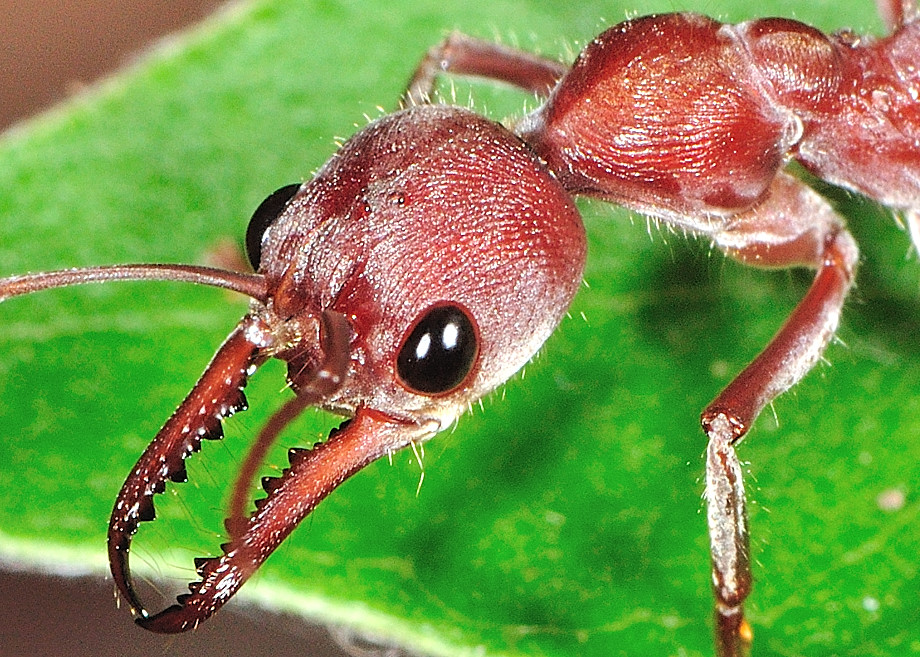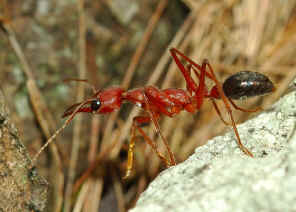|
| |
- This page contains pictures and information about Bulldog Ants and
Jumper Ants that we
found in the Brisbane area, Queensland, Australia.
-
 -
- The ants in subfamily Myrmeciinae are among the largest ants, often reach
15 mm, up to 45mm, in body length. The Myrmeciinae are found almost
exclusively in Australia.
-
- They are easily recognized by
their large body size, large eyes and long forward mandibles. The workers
possess ocelli and sting well developed. They are often in
bright colours. Ants in this
subfamily are considered to be the most
primitive of all living ants. They have the relatively simple social
structure. Their workers and queens are about the same size.
-
- They are fast and aggressive. They have good vision. They show a strong and well developed sting. They will not hesitate to deliver a painful
stings to any intruder.
-
 
 -
- Ants in Myrmeciinae have the mesosoma attached to the gaster by two distinct
segments, the petiole and postpetiole. The
mandibles are very long and straight, with teeth along their
inner margin. There is the sting at the tip of their gaster.
-
- Workers forage on ground or on low vegetation during the day. A few
species will also forage at night. They collect nectar as well as prey on
insects. Most species nest in soil, a few in rotten logs. Their nest is usually domed shape on ground covered with plant materials.
Their colony is small, usually up to a few workers.
-
- The subfamily contains a single living genus Myrmecia.
-
- Bull Ants in this group are large in size with long legs.
-
- Giant Red Bull Ant
  - Myrmecia
gulosa, body length 25mm
- We found the Giant Red Bull Ant nest entry when we were walking up to top of Mt
Gravatt. It was next to the footpath. There were not much activity. Just
inside the nest entry, there were a few guards standing by. When we came
within a meter, they ran out and put up a attack posture. Fir more
information and pictures please visit this page.
-
-
- Giant Brown Bull Ant
  - Myrmecia pyriformis or M. brevinoda, body length 25mm
- In Brisbane Forest Park, we found another species of Bulldog Ants.
They are dark brown in colour. Their hind legs are not as strong as the
species shown above, we did not see it jumping. We found this ant foraging alone on the ground. It was very aggressive.
When we came close, it did not retreat but put a fighting posture, waving its
head with its huge jaws. More information and pictures in this page.
-
-
- The Bull Ants in this group are medium in size. They are characterized by
the reduced teeth on mandibles. Their body colour is black but the legs may
be different colours.
-
- Toothless Bull Ant

 - Myrmecia fulviculis, or M. mandibularis, body length 15mm
- The ant has the
black head and body, red legs and golden abdomen. Notice its jaws are
relatively smooth comparing with other bull ants, i.e., its common name
Toothless Bull Ant. More information and pictures can be found in this page.
-
-
- Bull Ants in this group is small to medium in size. They have very long
legs
-
- Jumper Ant
  - Myrmecia nigrocincta, body length 15mm
- We found those Jumper Ants in Brisbane Toohey Forest. The
workers foraging alone on low vegetation during the day. They are large in
body size, with large eyes and elongated mandibles. They are bright colour,
with dark green head and brown body and dark brown legs.
More information in this page.
-
-
- Giant Jumper Ants

 - Myrmecia sp., body length 25mm
- We occasionally found this large ant foraging alone on forest ground. They
are dark blue and brown in colours. The colour patterns are exactly the same
as the Jumper Ants above but double the body size. So we called them Giant
Jumper Ants. We have more pictures and information in this page.
-
-
- Toothed Bull Ant

 - Myrmecia chrysogaster, body length 15mm
- This medium size bull ant is found either on leaves or tree trunk. Usually
we found a small group of them running up and down along tree trunk. Please check this page for more information.
-
-
- Ants in this group are small in size as Bull Ants.
-
- Baby Bull Ant

 - Myrmecia urens, body length 12mm
- Baby Bull Ant is the smallest among the Bulldog Ants family. We found one
resting on a gum tree trunk in Karawatha Forest in mid September. More
information and pictures please find in this page.
-
-
- Unknown Bull Ant


 - ? Myrmecia sp., body length 20mm
- We found this golden and black bull ant on Eugenia Circuit near Simpson
Falls on Feb 2012.
-
- Jumper Ants Sting
-

 -
- Our visitor Cheryl sent us email about her experience with Jumper Ants
sting;
-
- "We put down a tarpaulin and picnic rug on medium length grass in a little visited spot (not a regular picnic area) on the northern edge of Mt Tamborine. The next thing I knew, I was being literally 'aggressively attacked' by a swarm of jumping ants, black and yellow in colour. I ran away, trying madly to shake the things off, and eventually ensconced myself back in the car where I continued to pluck them off one by one.
-
- "I was screaming with the most horrific pain, especially in the arch of my left foot which suffered multiple bites/stings. I continued to scream in agony for about 10 minutes. I went pale and cold and clammy; I felt nauseous, and my heart palpitated.
-
- "Fortunately we had some 'Soov' in the car, which I rubbed into the affected areas; and I applied ice from out of our esky. But even so, it took a couple of hours for the pain to dissipate."
- Reference:
- 1. Jumper ant allergy
- Allergy Capital, 2005.
- 2. Myrmecia
(bull ants, jack jumpers) - myrmecos.net,
2005.
-
3. Australian
Ant Image Database - Australian Ant Image Database, R.W Taylor.
-
4. Myrmecia
Fabricius, 1804 - CSIRO, 2010. Ants Down Under, viewed 15 March 2010, <http://anic.ento.csiro.au/ants>.
-
5. Australian Ants: Their Biology and Identification - S Shattuck, Natalie J Barnett, CSIRO,
1999, p119.
-
6. Ants - subfamily Myrmeciinae - lifeunseen.com, Nick Monaghan.
-
7. Ants of the genus Myrmecia Fabricius: a review of the species groups and their phylogenetic relationships (Hymenoptera: Formicidae: Myrmeciinae) - Kazuo Ogata, CSIRO, 1991.
-
8. Common names of northern Australian ants - CSIRO Tropical Ecosystems Research Centre.
-
[ Up ] [ Myrmeciinae ] [ Pseudomyrmecinae ] [ Myrmicinae ] [ Ponerinae ] [ Formicinae ] [ Dolichoderinae ] [ Not Known Ants ]
| |
|























